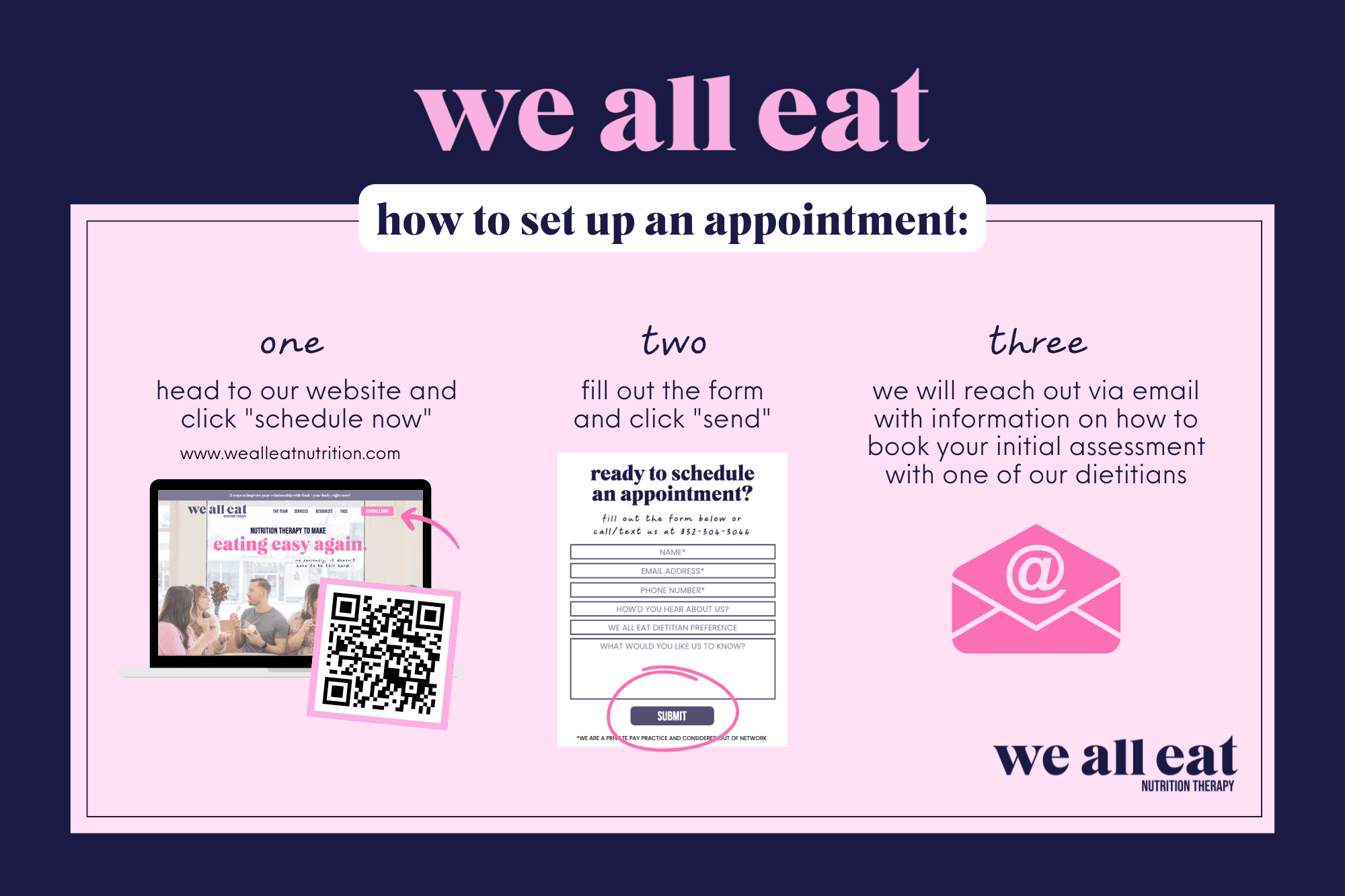June 20, 2025
If you’ve spent years following diets, tracking calories, or stressing over food rules, you may be wondering if there’s another way. A way that doesn’t involve shame, restriction, or obsessing over every bite. That’s where intuitive eating comes in.
This blog post will walk you through what intuitive eating is, how it works, why it can be hard to begin, and simple steps to get started.
If you’re ready to rebuild trust with your body and find peace with food, this guide is for you.

What Is Intuitive Eating?
Intuitive eating is a non-diet approach to nutrition that helps you reconnect with your body’s natural hunger, fullness, and satisfaction cues.
It was developed by two registered dietitians, Evelyn Tribole and Elyse Resch, as an evidence-based way to move away from dieting and into a more peaceful, sustainable relationship with food.
A common question to have is “what does eating intuitively mean?”. In short, eating intuitively means:
- Listening to your body instead of external rules
- Giving yourself permission to eat all foods without guilt
- Honoring hunger and fullness cues
- Respecting your body, even if you don’t love it
- Practicing gentle nutrition without obsessing over “eating perfectly”
At its core, intuitive eating is about healing your relationship with food and body.
It’s not a weight loss plan. It’s a framework that prioritizes self-care, body respect, and eating in a way that feels good—physically, mentally, and emotionally.
Why It’s Hard to Start Intuitive Eating (And Why That’s Normal!)
If you feel confused, skeptical, or even scared about intuitive eating, you’re not alone. Many people struggle with this in the beginning—especially if they’ve been deeply entrenched in diet culture.
You might be thinking:
- “If I let myself eat ____ , I won’t stop.”
- “I don’t trust when I’m hungry or full.”
- “How can this be healthy if there are no rules?”
These fears are completely valid. When you’ve spent years ignoring your body’s natural cues, it’s normal to feel disconnected from its signals.
It takes time to unlearn restrictive patterns and relearn how to listen inward. The good news? That reconnection is possible. And it starts with self-compassion.

Foundational Steps for How to Eat Intuitively
If you’re wondering how to start intuitive eating, here are five foundational steps that can help you ease into the process:
1. Give Yourself Unconditional Permission to Eat
This is often the hardest (but most important) step. Diet culture teaches us that food must be earned or limited. Intuitive eating teaches the opposite: all foods fit.
When you remove restrictions, food loses its power. You begin to realize that a cookie is just a cookie—not a test of willpower.
2. Eat Regularly Throughout the Day
Eating intuitively doesn’t mean waiting until you’re ravenous. In fact, skipping meals can make it even harder to tune into hunger cues. Start by eating consistent meals and snacks to help stabilize your energy and mood.
3. Notice Hunger and Fullness Cues
Take a moment before, during, and after meals to check in with your body. Are you starting to feel full? Are you still hungry? Are you satisfied? At first, these signals may be subtle or hard to interpret, and that’s okay. With time and practice, they become easier to recognize.
4. Explore Emotional Eating with Curiosity
Emotional eating is not a failure—it’s a signal. Instead of feeling ashamed, try asking: What do I need right now? Am I lonely, tired, overwhelmed? Food might be part of the solution, AND so can rest, support, or connection.
5. Reject Diet Mentality
Throw out the diet books, unfollow social media accounts that push weight loss, and give yourself permission to live outside the diet cycle. This mindset shift is ongoing, but every step counts.
Gentle Nutrition: How to Nourish Without Obsession
One of the most misunderstood parts of intuitive eating is the principle of gentle nutrition. Some worry that intuitive eating means throwing nutrition out the window—but that couldn’t be further from the truth.
Gentle nutrition means considering nutrition in a way that supports your health and well-being without guilt, obsession, or rigid rules.
It might look like:
- Adding protein to meals to feel fuller longer
- Including fiber-rich foods to support digestion
- Drinking enough water to stay hydrated
- Exploring how different foods make your body feel
The key? Gentle nutrition comes after building trust with your body and breaking free from restriction. When your relationship with food is grounded in care instead of control, nourishing choices become much easier.
What to Expect Emotionally and Physically
Starting intuitive eating can bring up a lot of emotions. Relief, hope, freedom—but also fear, frustration, and grief. It’s normal to miss the “control” of dieting, even if it was harmful.
You might:
- Feel uncomfortable eating foods you previously limited
- Struggle to trust your hunger or fullness cues
- Worry that you’re “doing it wrong” when making food choices
Physically, your body might be adjusting too. You might feel hungrier as your body learns to trust that food is consistently coming. Or you might crave foods you didn’t let yourself have before.
Over time, these changes will level out, your body will begin to feel safe, and food will lose its emotional charge.
How a Non-Diet Dietitian Can Help
Doing this work alone can feel overwhelming. That’s where we come in.
At We All Eat Nutrition Therapy, our non-diet dietitians specialize in supporting clients on their intuitive eating journey. We help you:
- Reconnect with hunger and fullness cues
- Make peace with food (even the ones that scare you!)
- Practice gentle nutrition in a realistic, supportive way
- Understand the emotions and beliefs behind eating patterns
Whether you’re brand new to intuitive eating or stuck somewhere along the way, our team can walk alongside you with compassion, knowledge, and care.

If you’re tired of dieting, sick of the food rules, and ready to feel more peace with eating, intuitive eating is a powerful place to start. It won’t happen overnight. But it will happen with time, support, and trust.
You deserve to feel at home in your body. You deserve to eat without guilt. You deserve to nourish yourself with confidence.
Ready to begin?
Book a session with one of our non-diet dietitians here or call/text 832-304-3044 and we’ll help you take the first step.
Let’s build a more peaceful relationship with food—together.
Intuitive eating is about more than just food—it’s about trust, compassion, and reconnecting with your body’s wisdom.
Throughout this guide, we explored what intuitive eating is (and isn’t), why it’s normal to struggle at first, and how gentle, supportive steps can help you begin.
Whether you’re learning to eat intuitively for the first time or re-learning after years of dieting, know that you’re not alone.
With tools like gentle nutrition and the support of a non-diet dietitian, you can build a nourishing relationship with food—one that honors your body and your well-being every step of the way.